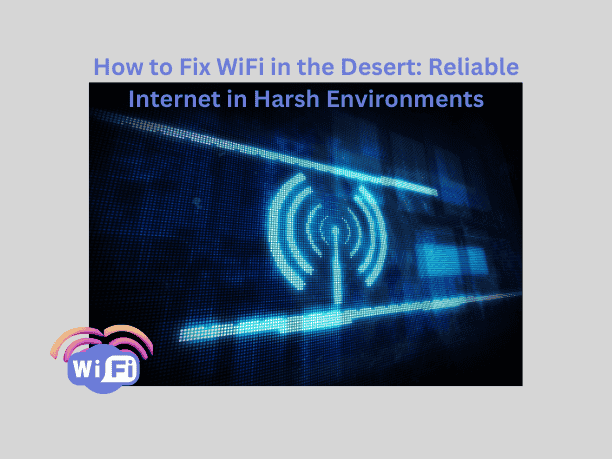Maintaining a reliable WiFi connection in the desert might seem impossible.How to Fix WiFi in the Desert, desert WiFi solutions , outdoor WiFi setup ,long-range WiFi access point ,remote area internet ,rugged WiFi equipment ,WiFi for harsh environments ,wireless internet in desert ,satellite internet for remote areas, solar-powered WiFi system, WiFi without electricity, outdoor mesh WiFi network, extreme weather WiFi ,remote connectivity solutions,
4G LTE WiFi router ,Starlink in the desert, desert internet setup, dust-proof WiFi router ,heat-resistant access point, off-grid internet, wireless connectivity in remote areas .However, with the right tools and techniques, you can establish strong and stable wireless connectivity even in the most remote and rugged desert locations. In this guide, we’ll show you how to fix WiFi in the desert using long-range WiFi solutions, rugged outdoor access points, solar-powered systems, and more.
Start by Surveying the Desert Terrain
Before you install any equipment, you must understand your environment. Deserts often feature flat, open spaces, but sand dunes, rocks, and long distances can still disrupt WiFi signals. Therefore, begin by mapping out your coverage area and identifying where you need connectivity whether it’s for a desert camp, research station, or remote facility.
Additionally, choose elevated positions for your devices to create clear line-of-sight between access points. This step improves signal strength and reduces interference. Desert WiFi installation always benefits from proper planning.

Choose the Right Rugged Outdoor WiFi Equipment
Next, select equipment designed to withstand extreme desert conditions. Standard routers and access points won’t survive long under scorching heat, blowing dust, and unpredictable weather. Instead, opt for IP67-rated outdoor WiFi devices such as:
Ubiquiti UniFi AC Mesh
Grandstream GWN7664LR
Ruijie RG-RAP6262(G)
These models handle high temperatures, sand, and outdoor exposure, making them ideal for desert environments. Moreover, their powerful antennas support long-range wireless connectivity, which is essential in open desert landscapes.
Extend Coverage with Long-Range WiFi Access Points
Since traditional WiFi routers have limited range, you’ll need long-range access points to cover wide desert areas. Install high-gain antennas on masts or poles to ensure maximum signal reach. Even better, create a wireless mesh network to maintain connectivity across multiple access points.
By linking outdoor WiFi access points through a mesh topology, you can distribute internet over vast spaces without running physical cables perfect for desert deployments.
Use LTE Routers or Satellite Internet When Cables Aren’t Available
When wired internet isn’t an option, use 4G/5G LTE routers or satellite internet to bring connectivity to your desert location. LTE routers with external antennas can amplify weak cellular signals, while satellite internet services like Starlink offer high-speed internet in extremely remote areas.
Connect your LTE or satellite modem to a WiFi router or mesh access point to share the signal. As a result, you’ll achieve broad wireless coverage in the desert, even miles away from urban centers.
Power Your Network with Solar Energy
Most desert regions lack access to stable electricity. Fortunately, solar-powered WiFi systems offer a sustainable and reliable solution. Use solar panels paired with lithium batteries to power your routers, switches, and access points around the clock.
When designing your solar setup, calculate total power consumption and ensure enough capacity for 24/7 internet uptime. Choose energy-efficient devices to reduce the solar load. This method is perfect for off-grid desert WiFi installations.
Monitor and Manage Your Network Remotely
After installation, don’t forget to maintain your network remotely. Use cloud-based management platforms such as UniFi Controller, Ruijie Cloud, or Omada Cloud to monitor performance, adjust settings, and receive alerts.
These platforms allow you to manage desert WiFi networks from anywhere, which is essential when working in isolated regions. Additionally, they help detect issues early like overheating, poor signal strength, or disconnected devices.
Protect Your Equipment from Sand, Dust, and Heat
Finally, ensure your hardware stays operational in harsh desert conditions. Use sealed, weatherproof enclosures for all network gear. Mount your devices off the ground to avoid sand accumulation. Apply mesh filters and passive cooling techniques to prevent overheating.
Routine maintenance, including dusting and visual inspections, will extend the life of your desert WiFi setup. These preventive steps keep your network running smoothly despite the climate.
Stay Connected Even in the Harshest Climates
To fix WiFi in the desert, you need a blend of smart planning, rugged hardware, and creative solutions like solar power and satellite internet. By using long-range WiFi access points, weatherproof devices, and remote monitoring tools, you can build a reliable desert internet network that works 24/7.
Whether you’re managing a construction site, a desert research station, or a temporary camp, these strategies ensure you stay connected no matter how remote the location.
